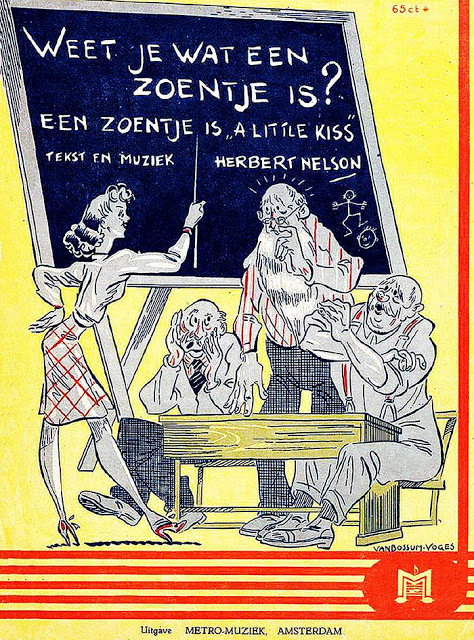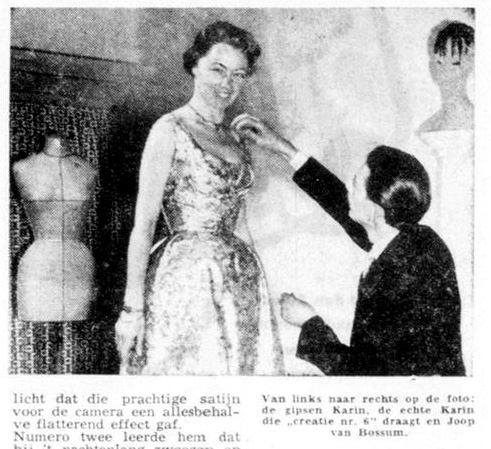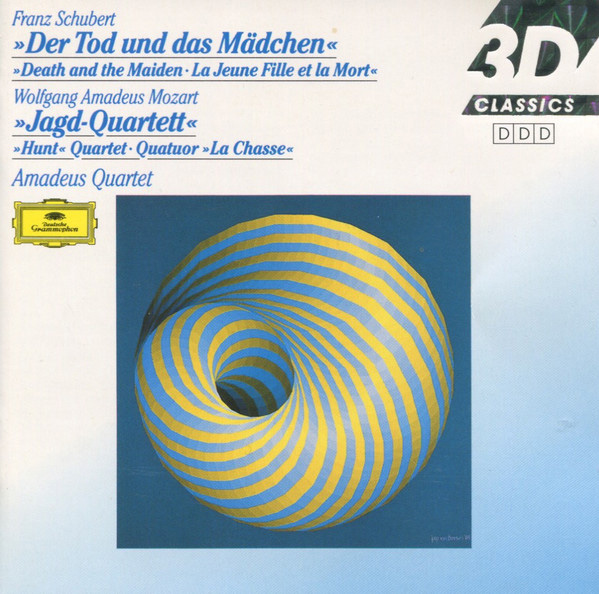'Pieter Cannegieter' (Zeeuwsch Dagblad, 24 October 1952).
Joop van Bossum was a Dutch illustrator, couturier, graphic artist, comic artist and sculptor. In the second half of the 1940s, he shared a commercial art studio with his brother-in-law Carol Voges, and also created the short-lived newspaper comic strips 'Gertjan en Maartje' (1949) and 'Pieter Cannegieter' (1949).
Early life and career
Born in Amsterdam in 1922, Johannes Petrus van Bossum studied Decorative Arts at the local Graphic School. As a painter he was largely self-taught. Around 1945, he presumably began his assocation with his brother-in-law, the comic artist/illustrator Carol Voges, who was married to his sister Geertruida Maria (Tru) van Bossum and who was at the time still working for the Toonder Studio's in Amsterdam. Joop van Bossum was responsible for the texts in rhyme of four children's booklets with Marten Toonder's 'Tom Poes', published by D. Blazer & Metz in Amersfoort in 1945-1946: 'Tom Poes en de Oude Ruïne', 'Tom Poes aan het Strand', 'Tom Poes en de Begraven Schat' and 'Tom Poes in het Luna Park'.
Cover illustration for the sheet music book 'Weet Je Wat Een Zoentje Is?'.
Van Bossum-Voges
One of Van Bossum and Voges' earliest collaborations was the sheet music for the song 'Weet Je Wat Een Zoentje Is?' (Metro-Muziek, 1945) by Herbert Nelson. The two men also made the illustrations of the children's book 'De Muizen en de Mooie Hoed' by Pieter van Hemert (Kroonder, 1945) and the 'Prikkebaard' series by P.H. Fruithof (Kroonder, 1946). They eventually established their "advertising/consultancy firm" Van Bossum-Voges at the Eslaan in Bussum. Van Bossum-Voges designed advertisements and logos for local businesses, most notably the cocoa and chocolate factory Bensdorp. For its house organ, they produced the comic strip 'Bonzo Op Speurtocht!', full of inside jokes.
Advertisement for Van Bossum and Voges' advertising company.
Professor Créghel
Voges and Van Bossum also developed a couple of newspaper comics. Their main co-production was 'Professor Créghel', which ran in the papers of the "Rotterdams Kwartet" group (De Rotterdammer, Nieuwe Haagsche Courant, Nieuwe Leidsche Courant en Dordtsch Dagblad) between 22 July 1947 and 12 May 1949. In the first story, the dandy professor with his trademark bowler hat, handlebar mustache, eyeglass and cigarette holder is caught up in a scheme to overthrow King Krelis of Boelmania, who happens to be his spitting image. Luckily the cunning professor is able to save the day. Seven more stories followed, written by Arnold Goosen, until the series ended after a total of 542 daily episodes. The Kwartet's publisher, CND, released two landscape-formatted booklets in 1950, as well as a 1948 calendar featuring the professor. De Eekhoorn published four books of 'Professor Créghel' in 1976. Shortly after the final episode was published, the children's choir Ex Animo in Leiden performed a stage show based on the comic, with the title 'Het Avontuur van Koning Goedhart en Professor Créghel' (18 May 1949). Van Bossum's role in the production remains uncertain, since the art is typically Voges.
'De Avonturen van Gertjan en Maartje', from Zeeuwsch Dagblad of 8 April 1952.
Solo comics
J.P. van Bossum is known to have made two newspaper comics of his own, which appeared in local newspapers like the Nijkerkse Courant and the Nieuwe Haagsche Courant around 1949. The first serial was 'De Avonturen van Gertjan en Maartje' (400 daily episodes). It told the magical adventures of the boy Gertjan and his sister Maartje with a group of gnomes. Some episodes are signed "N. Tromp", so there might be another artist involved. Van Bossum's next creation 'Pieter Cannegieter' (about 170-180 daily episodes) was about a young, pixie-like boy who came to life from an old picture book. He had all kinds of absurd adventures with his crow Karolus. 'Gerjan en Maartje' was reprinted in Zeeuwsch Dagblad between 2 June 1951 and 22 October 1952, followed by 'Pieter Cannegieter' between 23 October 1952 and late May 1953. 'Pieter Cannegieter' was also part of the portfolio of Ton de Zwaan's Swan Features Syndicate, established in 1953, so there might be reprints of a later date.
'Pieter Cannegieter' (Zeeuwsch Dagblad, 9 May 1953).
Fashion career
The partnership between Van Bossum and Voges apparently didn't outlive the 1940s. Voges remained active in comics and illustration, while Van Bossum turned to other art forms. During the 1950s, he and his wife ran a small fashion store near the Bussum railway, called Bettina Boutique. The pair made their own designs; most notably evening dresses for the announcers of broadcasting corporation VARA. The collaboration started in 1956, when announcer Karin Kraaykamp needed a dress in three days. She was about to host the very first National Song Festival to select the country's representative for the Eurovision Song Contest. According to an article in De Telegraaf on 23 March 1957, Van Bossum had never watched television himself, but succeeded in his assignment. Within no time he was hired to design more dresses. In a way, Van Bossum was a pioneer during the early days of Dutch television. With trial and error, he learned which fabrics and motifs worked on (black-and-white) TV, and which didn't.
Joop van Bossum with Karin Kraaykamp (De Telegraaf, 23 March 1957).
Painting and other graphic art career
Later in life, Joop van Bossum lived in Laren (around 1982) and then in Soest (around 1992). He had shifted activities once again, and was now active as a painter, graphic designer and sculptor. He specialized in geometric and abstract figures, working with techniques like screen printing, gouache and acrylic. He was a member of painting associations like the Gooise Schildersvereniging and BKV Laren-Blaricum, and of the artist collective Konkreet. The latter group had formed in 1986 during the 'Impossible Figures' exposition in the Museum for Contemporary Art in Utrecht. Besides Van Bossum, Konkreet consisted of Monika Buch, Dirk Huizer, Arthur Stibbe and Gerard Traarbach. All five worked on their own pieces of art, but combined their forces for joint exhibitions and special assignments. Among their commercial projects were record sleeve designs for music publisher Deutsche Grammophon, and developing designs and artworks for a new office building of insurance company Ubo Verzekeringen. Joop van Bossum died in 2018 at age 95.
One of Joop van Bossum's designs, appearing on a record sleeve of Deutsche Grammophon in 1983.
Disclaimer
Considering the wide variation between Joop van Bossum's artistic endeavors, there is a possibility that there might have been three artists of the same name. Still, it seems unlikely that they all worked in the same Gooi region, while of all three there is no information available from other time periods. Confirmation regarding this matter or additional information about Joop van Bossum's further life and career is much appreciated!
Final episode of 'Gertjan en Maartje' (Zeeuwsch Dagblad, 22 October 1952).










